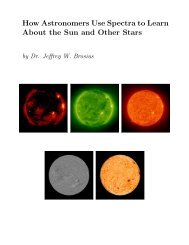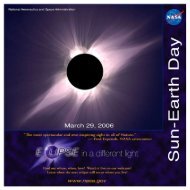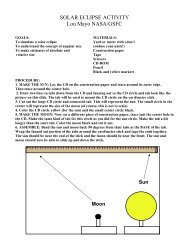Storm Signals Flip Chart V4 - Sun Earth Day 2005
Storm Signals Flip Chart V4 - Sun Earth Day 2005
Storm Signals Flip Chart V4 - Sun Earth Day 2005
Create successful ePaper yourself
Turn your PDF publications into a flip-book with our unique Google optimized e-Paper software.
ANALYSIS TIPS:<br />
Sharp spikes in the graph are usually due to man-made<br />
signals or lightning strikes.<br />
The graph of a solar storm would show a gradual rise<br />
and fall in the signal over several seconds to several<br />
minutes and would look somewhat like a shark’s fin.<br />
PAGE – 1B INFORMATION CARD<br />
Radio JOVE Data Archive<br />
ABOUT THE DATA:<br />
When a solar flare or coronal mass ejection<br />
erupts, hot, charged particles are accelerated<br />
away from the <strong>Sun</strong>. When this happens, a<br />
radio signal is emitted that reaches <strong>Earth</strong> in a<br />
little over 8 minutes providing the first signal<br />
that a solar storm is headed our way.<br />
However, the particles from that same storm<br />
usually take up to 3 days to reach <strong>Earth</strong>.<br />
Solar flares and Coronal Mass Ejections<br />
(CMEs) emit a broad range of light. Most of<br />
this light is invisible to us. To detect solar<br />
storms we will use radio waves, x--rays, and<br />
ultraviolet light. Radio waves are especially<br />
useful because they can be measured by<br />
instruments on the <strong>Earth</strong> and in interplanetary<br />
space.










